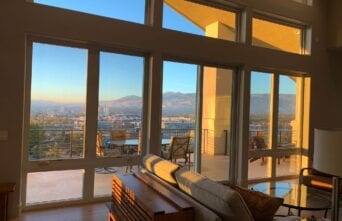LED Lighting: The Future’s So Bright We Gotta Wear Shades!

If you haven’t been living in a cave, I’m sure you’ve heard about LED’s by now. Just what is an LED? The LED or light emitting diode is the biggest change in lighting since the invention of the light bulb.
Our ancient ancestors lit their way with fire. Later came kerosene lamps. Edison help to develop the incandescent light bulb in 1880. Fluorescent lights followed that. Now we are entering the LED era. Why is this so important? It’s all about the power.
Incandescent bulbs make light by running an electric current through a tiny wire called a filament. The resistance in the wire causes it to heat up, and glow. Resistance is the evil twin of efficiency. It’s like friction in a wire, slowing down the free flow of electricity. This is a very poor way to produce light. Fluorescent bulbs are much more efficient than incandescent bulbs. They produce light by exciting molecules in a gas with an electric current, causing movement, and light. It takes a bit of power to get them going, but once it starts emitting light, it draws very little electricity. Constantly turning them on and off shortens the life of fluorescents tremendously. The CFLs (squiggly bulbs) of recent years have not stood up to the test of time.
In simple terms, a diode is an electrical component that allows a current to pass in one direction![]() from the p (positive) side, to the n (negative) side. When an electroluminescent material is used, this process will release a photon, a particle of light. The advantage of LEDs over other forms of light, are lower power consumption, and longer life.
from the p (positive) side, to the n (negative) side. When an electroluminescent material is used, this process will release a photon, a particle of light. The advantage of LEDs over other forms of light, are lower power consumption, and longer life.
Lumens are a measurement of light intensity. Wattage is a measurement of power consumption. A higher lumen to watt ratio means more efficiency. A typical incandescent bulb will produce 15 lumens/watt. The most efficient fluorescent light will give you about 100 lumens/watt. A good LED will brighten your day to the tune of 160 lumens per watt.
The life expectancy of today’s LEDs range from 25,000 up to 100,000 hours. They are not affected by constant on/off switching. Fluorescent bulbs have a lifetime of 10,000 to 15,000 hours, and can fail much sooner with constant cycling. Incandescants generally last from 1,000 to 2,000 hours.
Because of their higher efficiency, LEDs run much cooler. They are also easily dimable, and come on instantly. Another plus of LEDs, is the availability of different colors without the use of filters or lenses
Some would argue that a major disadvantage of LEDs is their high initial cost. If you go to your favorite home improvement store to buy an LED for your house, you could be in for sticker shock. The high cost of replacement LED bulbs is partly due to the fact that they need a transformer in the bulb. LEDs run off of low voltage DC current, 12 or 24 volts. Your house (in the USofA), has 120 volt AC current. The transformer necessary to supply the LED with the proper voltage increases its cost significantly. If you had a system that supplied low voltage DC current directly to your light fixture, as in an RV or residence powered with a renewable energy source, the cost of using the LEDs is much less. This makes LED lighting a perfect choice for an off grid home. But that’s a subject for another day.
If you’re interested in reading more about LED’s, you can go to Fran Sloan’s blog, MyDecorArticles.com
Thank you to my husband Greg for his assistance with this post.
If you have any questions, comments, or experience with LED’s, your comments are, as always, much appreciated.


